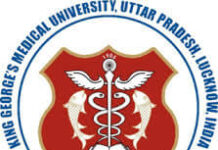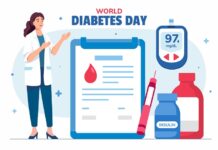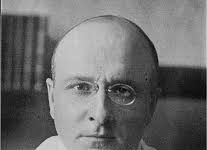Abstract
Healthcare is one of the most important issues in India, but often overlooked and not discussed during election campaigns.Poor medical infrastructure, insufficient public health services, and unmet healthcare needs persist in the country. Though people do want the right, high quality, and cost-effective medical treatment when they fall sick, this is put on the backseat when they are healthy, thereby the demand and struggle for health care in the future remains un-articulated by both the people and the administration. India has a heavy disease burden especially in children under 5 years and women and of lifestyle diseases like stroke, ischemic heart disease, hypertension, diabetes and cancer, now affecting younger adults. Increased dependence on private health care result in high out of pocket expenditure and a huge economic burden. Budgetary allocation for health consistently remains low and has not achieved 2.5% of GDP as recommended under the National Health Policy 2017 and 15th Finance Commission. Improving the public healthcare infrastructure and access, as well as addressing private healthcare costs, is the need of the hour especially during formation of a new democratic order in our country.
Keywords: healthcare, election, health policy, public healthcare, GDP
Conflict of Interest: None declared
Source of Support: None declared
Introduction
In order to create a healthier and more prosperous India, political leaders, voters, and other stakeholders must understand how important healthcare is.
Healthcare is often overlooked and forgotten during election campaigns in favour of more pressing and so-called popular issues. Based on a summary analysis of opinion polls conducted by various national and transnational agencies, it was seen that inflation, roads-electricity-water, unemployment, corruption, economic slowdown, security-terrorism, and religious polarization, were the most common issues discussed during elections in India across classes and regions.1 Health or healthcare did not figure in the list, unlike in the west like in USA and EU, where healthcare consistently stays among the top three concerns of the voters.
Healthcare issues that need to be addressed
Public Healthcare
Poor medical infrastructure, insufficient public health services, and unmet healthcare needs persist in the country. The most vocal sections of society ‘the educated middle class’ often do not access public health services, instead preferring the private sector. Therefore, public healthcare becomes a seldomly voiced subject, and demands to improve government health services are not raised strongly.
Every year, an estimated 37 million Indians are pushed to the brink of financial ruin and below the poverty line by medical emergencies and disease burden, due to lack of adequate public health facilities, and dependence on private healthcare, that are least monitored by the government, and lead to violation of the roles and responsibilities they owe to the community.2 Of the four different models of health expenditure, India follows the out-of-pocket (OOP) expenditure model rampantly as accounting for 70% of total health expenditure.
Healthcare in India has undergone a transformation from its initial government-funded structure to a privatised and corporatised healthcare system and
*Advisor – National Communicable Disease Control Programme, Consultant Community Health – Bhopal.
Email: drnpglobel@gmail.com
underfunded public sector wherein nearly 70% of all outpatient visits, about 58% of all inpatient episodes, and approximately 90% of dispensed medicines and diagnostic facilities in India are currently provided by the private sector.3 This transformation has resulted in a system where the most vulnerable segment bears the brunt.
As India gears up for the Lok Sabha polls, health remains conspicuously absent from the election discourses of most political parties. Many of these parties are uninterested in prioritising commitments on health in their poll agenda. Healthcare has suffered in the absence of adequate allocations in the Union budget under successive governments. The result is that election after election, medical infrastructure and services leave a lot to be desired.
Health Burden and Resource Allocation
India has a heavy disease burden with a recent WHO report stating that the country accounts for one-fifth of the total deaths occurring from stroke and ischemic heart disease, especially in younger adults.4
More than 57% of women (15-49 years) and 67% of children (below 5 years) are anaemic or have diarrhoea respectively, needing treatment in a health facility, according to the data of National Family Health Survey5.
Not only that, the NFHS data points to a wide incidence of hypertension and diabetes, while an ICMR report says that India will have a cancer incidence of 1.5 million and cancer burden as disability adjusted life years (DALY) of 29.8 million in 2025.6
The Public Health System on which most poor and lower middle classes depend, suffers from insufficient infrastructure and persistent shortfall of the public health workforce. Private health care is unaffordable, so as a result, out of pocket expenditure continues to be high. Budgetary allocation for health consistently remains low and has not achieved 2.5% of GDP as recommended under the National Health Policy 2017 and 15th Finance Commission.7 Allocation for health has remained stagnant at around 2% of the union budget in the last few years, according to the Centre for Budget Governance and Accountability. Despite it being known that investment in health brings back higher returns in GDP, there is no electoral dividend, as the impact is indirect and delayed.
It is to be noted that Ayushman Bharat scheme needs to be re-envisioned. The OPD expenditure is mostly out of pocket, which is not covered under Ayushman Bharat. It only covers treatment of certain diseases and that too after hospitalisation. Many chronic illnesses are not listed among the medical packages. This scheme provides medical coverage post discharge for 15 days only and many patients especially those with cancer require medical cover for a longer period of time.7 The Indian Medical Association feels that the public hospitals should be funded directly by the government and the PMJAY should be exclusively used for strategic purchase from the private sector.8 The pricing of services should be based on independent scientific costing on a district level basis.
The Indian Medical Association (IMA) has sought a hike in the healthcare expenditure from the current 1.1% of the GDP to 2.5% as envisaged in the 2017 National Health Policy. The IMA also suggested that as the GST is not payable on healthcare services, making service providers eligible for input tax credit would ensure that input taxes are not added to the cost of the services thereby providing some relief to patients. It was suggested that either some percentage of the total GST paid by healthcare providers be treated as advance tax or MAT (Minimum Alternative Tax) or the GST paid by them on equipment or otherwise should be reduced to 5%.8
Impact and Learning from the Pandemic
The Covid-19 pandemic led to some concerning facts being exposed. Worryingly, public health crises continue to evolve. India is expected to lose around $3.6 trillion worth of economic output owing to non-communicable diseases by 2030.9 The lack of preparation for these challenges looming in the near future is suggestive of policy apathy towards the challenges in public health management. This is unacceptable, given the likely drain on individual finances, national exchequer, and human capital.
The current government has often showcased achieving universal health coverage through the Pradhan Mantri Jan Arogya Yojana along with the creation of health and wellness centres providing diagnostic treatment. But this is not enough for a country that has only around 1.3 hospital beds per 1,000 people (far fewer than the recommended 3 beds per 1,000 people), so India needs an additional 2.6 million beds to meet the recommended ratio.10 When comparing to other G20 countries, India spends only $211 per capita on health care and $16 per capita on prevention, which the smallest amount in the G20, and about 2% of what the US spends on per capita health care.11
The combined central and state spending on health is less than 1.5% of India’s GDP, according to the NITI Aayog report.12 This miserly spending on healthcare by the state leads to a spike in out-of-pocket expenses, especially since the Clinical Establishment (Registration and Regulation) Act, which seeks to regulate expenses in private establishments, remains unimplemented. Health insurance coverage is also uneven, and the recent NITI Aayog report highlighted that only 15% of India’s workforce receives insurance support from employers.
Political leaders need to help the medical fraternity maintain the ‘purity of modern medicine’, and bring in strict measures to protect medical staff while on duty, reduce GST burden on healthcare products and insurance, and exempt small and medium hospitals up to 50 beds and clinics from the Clinical Establishments (Registration and Regulation) Act, 2010.
Conclusion
As the general election continues in phases, as well as in upcoming state and municipal elections, both the party campaigns and the people should keep healthcare in mind as an important point. According to the healthcare experts, people are keen to get the right treatment from the available health system, at any cost, only when they fall sick. When people are healthy and are not acutely sick, individually or even collectively, they don’t seem to feel the need for health care. Thus, demand and struggle for health care in the future remains un-articulated by both the people and the administration, and this must be addressed immediately, effectively and robustly. Improving the public healthcare infrastructure and access, as well as addressing private healthcare costs, is the need of the hour for our country.
References
- Chaturvedi S. Healthcare as an electoral agenda. Indian J Community Med. 2014 Jul;39(3):127-8.
- Dehury RK, Samal J, Coutinho S, Dehury P. How Does the Largely Unregulated Private Health Sector Impact the Indian Mass? Journal of Health Management. 2019;21(3):383-393.
- Selvaraj S, Karan AK, Srivastava S, Bhan N, Mukhopadhyay I. India Health Systems Review. Health Systems in Transition 2022; 11(1). World Health Organization 2022on behalf of the Asia Pacific Observatory on Health Systems and Policies. Available from https://apo.who.int/publications/i/item/india-health-system-review
- Kumar SA, Sinha N. Cardiovascular disease in India: A 360-degree overview. Medical Journal Armed Forces India 2020; 76(1):1-3.
- National Family Health Survey (NFHS-5), 2019-21 for India [Internet]. Cited May 09, 2024, Available from chrome-extension://efaidnbmnnnibpcajpcglclefindmkaj/https:/
/main.mohfw.gov.in/sites/default/files/NFHS-5_Phase-II_0.pdf - Sathishkumar, Krishnan; Chaturvedi, Meesha; Das, Priyanka; Stephen, S.; Mathur, Prashant. Cancer incidence estimates for 2022 & projection for 2025: Result from National Cancer Registry Programme, India. Indian Journal of Medical Research. Oct-Nov 2022;156(4-5):598-607.
- Health, a glaring hole in election discourse, say experts, The Economic Times [Internet], March 02, 2024. Cited May 09, 2024. Available from https://economictimes.indiatimes.com/news/elections/lok-sabha/india/health-a-glaring-hole-in-election-discourse-say-experts/articleshow/108162111.cms?from=mdr
- Use AB-PMJAY funds for private sector: IMA tells govt ahead of Budget. Business Standard [Internet], May 08, 2024. Cited May 09, 2024. Available from https://www.business-standard.com/budget/article/use-ab-pmjay-funds-for-private-sector-ima-tells-govt-ahead-of-budget-123012800014_1.html
- Non-communicable diseases to cost India around $3.6 trillion by 2030. Live Mint [Internet], May 17, 2023. Cited May 09, 2024. Available from https://www.livemint.com/news/india/noncommunicable-diseases-to-cost-india-around-3-6-trillion-by-2030-11684321146414.html
- India needs additional 2.4 million hospital beds to reach recommended ratio: Report. Economic Times [Internet].Nov 23, 2023. Cited May 09, 2024. Available from https://economictimes.indiatimes.com/news/india/india-needs-additional-2-4-million-hospital-beds-to-reach-recommended-ratio-report/articleshow/105450555.cms?from=mdr
- India’s health budget is just 2% of the USA’s spend but growing investment could reap huge returns. International Longevity Centre UK [Internet] Aug 14, 2023. Cited May 09, 2024. Available from https://ilcuk.org.uk/indias-health-budget-is-just-2-of-the-usas-spend/
- Health Insurance for India’s Missing Middle: Niti Ayog [Internet] October 2021. Cited May 09, 2024. Available from chrome-extension://efaidnbmnnnibpcajpcglclefindmkaj/https://www.niti.gov.in
/sites/default/files/2023-02/Health-Insurance-for-India%E2%80%99s-Missing-Middle_08-12-2021.pdf























